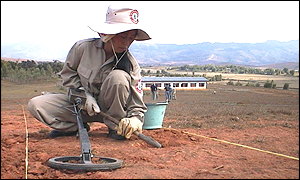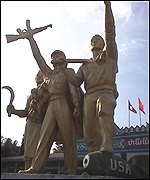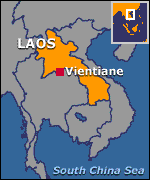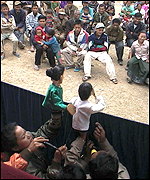
Inch by tortuous inch, the bomb clearance team edges its way up the stony hillside.
Each sweep of the electronic detectors produces high-pitched squawks, indicating the presence of metallic objects hidden in the soil.
Just about anywhere else, the objects in question would probably be harmless. But this is the Plain of Jars - the high, remote plateau in north-eastern Laos which, during the Vietnam war, earned the unenviable distinction of being the most heavily-bombed place on earth.
The team supervisor gestures down the hill towards the single-story wooden building that houses Ban Ilay lower secondary school.
"So far, we've found 210 cluster bombs within 50m of the school," he says. "There's bound to be many more."
No safety
In a corner of the field lie a dozen US-made BLU-64B cluster bombs, covered in mud but otherwise as lethal as the day they were dropped.
The devices have been connected with wire, and fitted with small charges of TNT. White sand bags are piled around them to help deaden the blast.
There are still millions of pieces of ordnance just laying out there |
Paul Stanford of the UK-based Mines Advisory Group
|
"We haven't had any accidents here for quite a while, because the children have been taught about the danger of handling the bombs. But no-one could ever feel entirely safe knowing they were scattered all around here."
In the field nearby, a man with a bullhorn tells anyone within earshot to keep their distance.
We take shelter in one of the classrooms, having first taken the precaution of opening all the windows, to prevent them being shattered.
The bullhorn sounds again: "Nung, song, sam [one, two, three]!"
A moment later, a huge explosion rocks the school building. Another pause, then the noise of earth and other debris raining down on the tin roof above our heads.
Unexploded bombs
It is 28 years since the United States ended its air war on Laos - a bombardment in which American B52s and other aircraft dropped more bombs than fell on all of Europe during World War II. Up to 30% of those bombs failed to detonate.
 A statue in the capital Vientiane, depicts the victory of communist Pathet Lao over US bombing
|
Our Landcruiser is lurching along one of the rutted tracks that passes for a road in Xiang Khouang - roads that were one of the prime targets of the US air force's attempts to stem the flow of Vietnamese troops and war supplies into Laos.
"We're destroying about 2,000 items a month," Mr Stanford says. "But we've only got three or four roving teams in this province so we have to prioritise."
It is at the Vientiane headquarters of the Lao National Unexploded Ordnance Programme - UXO-Lao for short - that the priorities of the clearance operations are set. Geographer Michael Sheinkman gestures to a computer screen.
"What you're looking at is a map of Xiang Khouang province, based on the historical records of the aerial bombardment during the conflict," Mr Sheinkman explains.
"The red dots represent fighter-bomber strikes. The yellow or orange circles represent areas that suffered carpet-bombing carried out by B52 aircraft."
Nine years of bombing
The lurid colours on the monitor make it plain that very little of Xiang Khouang escaped the nine years of bombardment.
How long it will take to finish with the problem? Maybe 50 years, 100 years - even more |
Bounpone Sayasenh, head of the Laos de-mining programme
|
Armed with this data, bomb disposal teams have some idea of the challenge confronting them in any part of the country.
"We identify a location where clearance is being considered," says Sheinkman.
 |
Many targets were struck time and again. In one case, a single stretch of the N7 highway leading from Xiang Khouang to the Vietnamese border was hit by 114 separate missions.
While there is no way of knowing from this information how many of the bombs dropped did not explode, the clearance teams can be sure they will have their work cut out.
Modest US contribution
The old Pentagon database is part of a distinctly modest American contribution to the work of UXO-Lao.
Washington spent an average of $2,190,124 a day prosecuting the air war in Indochina.
Today, the budget allowed by Congress on bomb and mine disposal work globally offers Laos a tiny fraction of that amount towards the cost of disposing of the long-term after-effects of the bombardment.
 Community awareness teams use puppets to inform villagers about the danger of handling unexploded battle ordnance
|
"Essentially because it is humanitarian aid we are looking at it to solve the problems of the people," says Stewart. "As long as the government here is willing to co-operate with the international community to address the problem, we on our side are willing to do our part."
Ms Stewart says its unlikely Congress would agree to increase the level of its assistance to Vientiane.
'Impossible task'
One obstacle is the recent resurgence of activity by anti-communist Lao resistance groups based in the US.
These include ethnic Hmong who - with CIA backing - fought against the communist Pathet Lao.
Two Lao-American opposition activists disappeared in Laos in 1999 and the Vientiane authorities have yet to offer an explanation.
All this is scant consolation to UXO-Lao's National Programme Director, Bounpone Sayasenh.
Without adequate funding from abroad, and from the US in particular, his bomb-clearance teams face an impossible task.
"Fifteen out of 17 provinces of Laos are contaminated by UXO," declares Bounpone.
"Our programme has been working nearly five years, and we have cleared just 1,000 hectares. How long it will take to finish with the problem? Maybe 50 years, 100 years - even more. I cannot tell."
| Search BBC News Online |
||
Advanced search options | ||
|
| |
|
| |
The BBC is not responsible for the content of external internet sites
